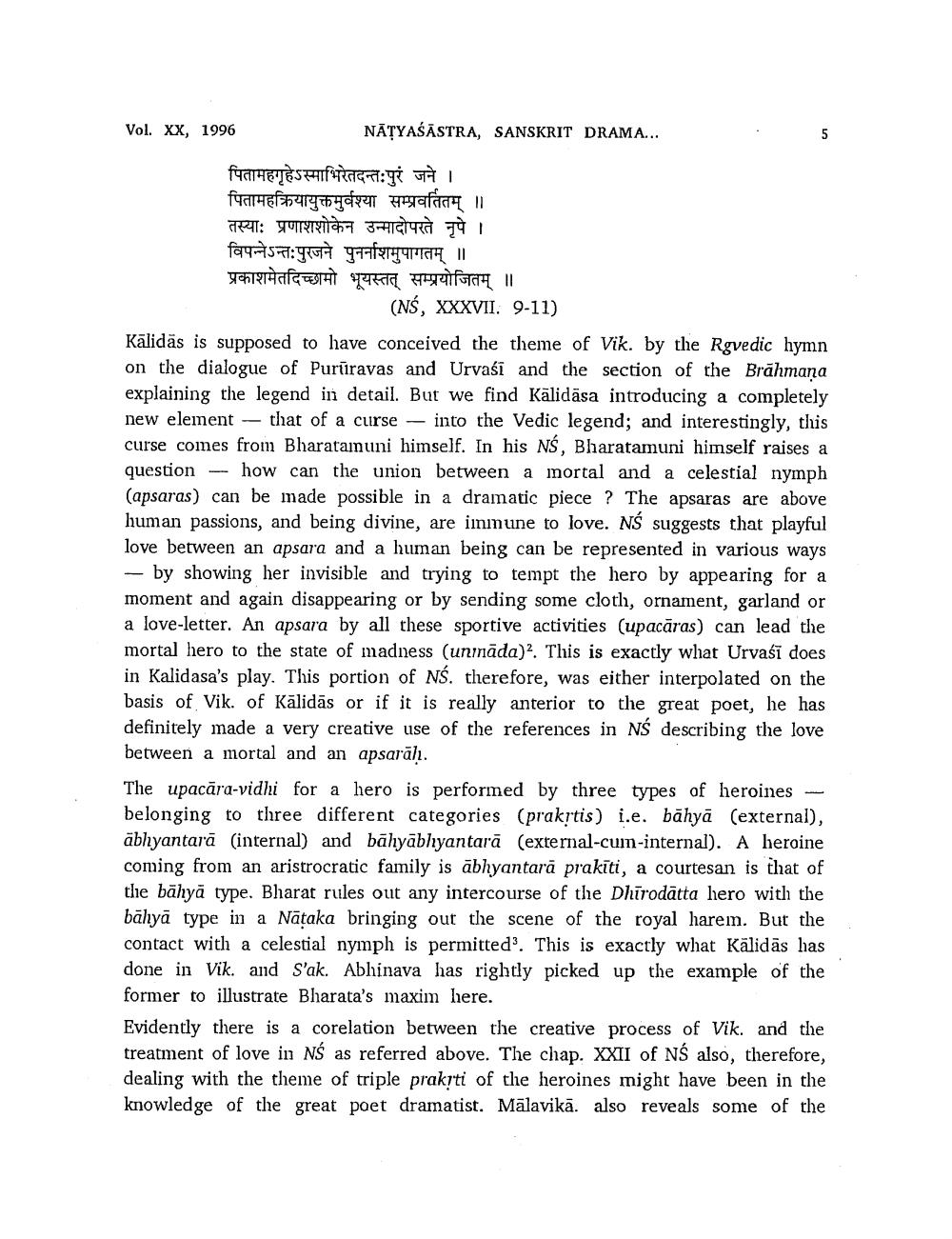Book Title: Sambodhi 1996 Vol 20 Author(s): Jitendra B Shah, N M Kansara Publisher: L D Indology Ahmedabad View full book textPage 9
________________ Vol. XX, 1996 NĀTYAŚĀSTRA, SANSKRIT DRAMA... पितामहगृहेऽस्माभिरेतदन्तःपुरं जने । पितामहक्रियायुक्तमुर्वश्या सम्प्रवर्तितम् ॥ तस्याः प्रणाशशोकेन उन्मादोपरते नृपे । विपन्नेऽन्तःपुरजने पुनर्नाशमुपागतम् ॥ प्रकाशमेतदिच्छामो भूयस्तत् सम्प्रयोजितम् ॥ (NŚ, XXXVII. 9-11) Kālidās is supposed to have conceived the theme of Vik. by the Rgvedic hymn on the dialogue of Purūravas and Urvasi and the section of the Brāhmaṇa explaining the legend in detail. But we find Kalidasa introducing a completely new element – that of a curse – into the Vedic legend; and interestingly, this curse comes from Bharatamuni himself. In his Nś, Bharatamuni himself raises a question - how can the union between a mortal and a celestial nymph (apsaras) can be made possible in a dramatic piece? The apsaras are above human passions, and being divine, are immune to love. Nś suggests that playful love between an apsara and a human being can be represented in various ways - by showing her invisible and trying to tempt the hero by appearing for a moment and again disappearing or by sending some cloth, ornament, garland or a love-letter. An apsara by all these sportive activities (upacāras) can lead the mortal hero to the state of madness (unmāda)? This is exactly what Urvašī does in Kalidasa's play. This portion of Nś. therefore, was either interpolated on the basis of Vik. of Kālidās or if it is really anterior to the great poet, he has definitely made a very creative use of the references in Nś describing the love between a mortal and an apsarāh. The upacāra-vidhi for a hero is performed by three types of heroines - belonging to three different categories (prakrtis) i.e. bāhyā (external), ābhyantarā (internal) and bāhyābhyantarā (external-cumn-internal). A heroine coming from an aristrocratic family is abhyantarā prakīti, a courtesan is that of the bāhyā type. Bharat rules out any intercourse of the Dhīrodātta hero with the bālyā type in a Nātaka bringing out the scene of the royal harem. But the contact with a celestial nymph is permitted. This is exactly what Kalidās las done in Vik. and S'ak. Abhinava has rightly picked up the example of the former to illustrate Bharata's maxim here. Evidently there is a corelation between the creative process of Vik. and the treatment of love in Nś as referred above. The chap. XXII of NŚ also, therefore, dealing with the theme of triple prakrti of the heroines might have been in the knowledge of the great poet dramatist. Mālavikā. also reveals some of the (external... :: bāhya mily is whzPage Navigation
1 ... 7 8 9 10 11 12 13 14 15 16 17 18 19 20 21 22 23 24 25 26 27 28 29 30 31 32 33 34 35 36 37 38 39 40 41 42 43 44 45 46 47 48 49 50 51 52 53 54 55 56 57 58 59 60 61 62 63 64 65 66 67 68 69 70 71 72 73 74 75 76 77 78 79 80 81 82 83 84 85 86 87 88 89 90 91 92 ... 220
